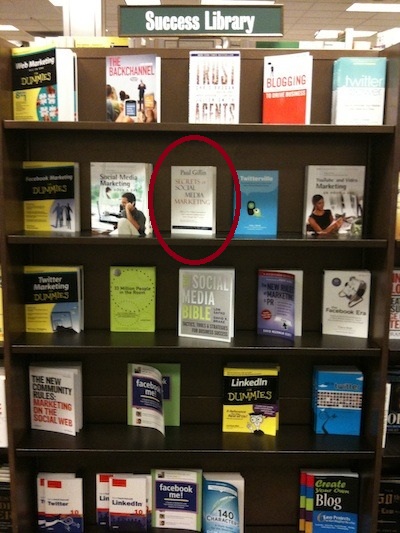B-to-B Book Update: Need Expertise in Organization, Lead Gen
Research for the business-to-business social marketing book that Eric Schwartzman and I are co-authoring is coming together nicely, but there are a couple of areas where we still need advice and case studies. We’re looking for experts who are willing to spare an hour or so of their time for a phone interview in the following areas:
Organizing for Social B-to-B
- Empowering employees to speak
- Integrating social media with conventional marketing
- Reskilling the organization
- Optimizing the marketing department organization
- Building bridges to other departments
6. Lead Generation
- Building social media into the selling cycle
- Tools for different stages of the funnel
- Developing quality leads
- Case studies needed here!
If you have a good story to tell or tips to share, contact Paul or Eric at paul{at}gillin{dot}com (@pgillin) or eric{at}ericschwartzman[dot]c0m (@ericschwartzman).
Help Wanted: Insight for BtoB Mag Articles
 I’m writing the social media section of BtoB magazine’s annual Interactive Marketing Guide. I’m looking for business-to-business marketers who can talk about the successes they’ve had in the past year and the challenges that they face going forward. I’m particularly interested in how marketers are wrestling with the issues of coordinating multiple platforms and setting policies that cover all the employees who may be using these platforms, whether on the company’s behalf or their own.
I’m writing the social media section of BtoB magazine’s annual Interactive Marketing Guide. I’m looking for business-to-business marketers who can talk about the successes they’ve had in the past year and the challenges that they face going forward. I’m particularly interested in how marketers are wrestling with the issues of coordinating multiple platforms and setting policies that cover all the employees who may be using these platforms, whether on the company’s behalf or their own.
I’m also looking for questions you would like to ask an expert in the area of b-to-b social marketing. What problems are you trying to solve? Where do you most need guidance? I’m even taking applications to be the expert!
The copy deadline is very tight: March 19. Please contact me ASAP if you can contribute in exchange for exposure in the leading b-to-b marketing publication! Tweets also welcome.
Curation’s Growing Value
 Like many people, I was glued to my computer and smart phone much of last Saturday monitoring news of the massive earthquake in Chile and awaiting, with morbid anticipation, the possibility that it could trigger deadly tidal waves in other parts of the world.
Like many people, I was glued to my computer and smart phone much of last Saturday monitoring news of the massive earthquake in Chile and awaiting, with morbid anticipation, the possibility that it could trigger deadly tidal waves in other parts of the world.
As the predicted 4 PM arrival of the first tsunami on Hawaii’s shores approached, I turned my attention mainly to Twitter. Three years ago, it probably would have been CNN or the New York Times, but Twitter brought a dimension to the coverage that I couldn’t get anywhere else: thousands of perspectives from around the world.
A tsunami is a visual event, a fact made clear to us more than five years ago when videos of the tragic waves that swept across Indonesia were posted on YouTube. News junkie that I am, I wanted to see the events in Hawaii in as close to real time as possible.
Instead of clicking around to various websites or hunkering down with one and hoping for the best, I was able to monitor a constant stream of advice from people pointing their followers to WebCams, live news coverage and reports from observers at the site. Most of these sources would have been unknown to me if it weren’t for Twitter. It was like having 1,000 eyes watching the media for me. Thankfully, the fears turned out to be unfounded.
No media organization would have delivered this many options for monitoring events. In fact, media organizations are hard-wired to do the opposite; an NBC affiliate would no sooner send viewers to a CBS station than a Ford dealer would send a prospective customer to buy a Toyota. But when the collective eyes of a geographically dispersed crowd are put to work without a competitive agenda, they can deliver a tapestry of views unlike anything we’ve ever seen.
Curative Value
This story dramatized to me one of the realities of new media landscape that I think will have huge implications in the future: curation is an increasingly important part of the information value chain. Wiktionary defines curation as “The act of organizing and maintaining a collection of artworks or artifacts,” but today the term applies equally well to information. Think of it: a decade ago we had relatively few sources of news about what was going on in the world. Even in the first decade of the Internet, we still relied mainly on traditional media for the story.
Today, three billion people carry around pocket-sized devices with built-in cameras, many capable of capturing full motion video. Some can even upload videos in minutes to a server. It won’t be long before wireless live WebCams are ubiquitous.
No longer is our problem lack of information; it’s that we’re drowning in information. That’s why curation is so important. Trusted curators who point us to the most valuable sources of information for our interests will become the new power brokers. Matt Drudge figured this out many years ago and a host of popular aggregators like BoingBoing.net, Digg.com, Metafilter and Fark.com have been building upon it with great success for more than five years.
Twitter adds a new dimension because it introduces so many new voices to the process. But Twitter is also imperfect; its great shortcoming is that no one can possibly keep up with it all. Another opportunity for curation.
Marketers should take this trend into account. Creating new content is important, but an equally valuable service is curating content from other sources. This demands a whole different set of skills as well as a new delivery channel. It also means ditching the “not invented here” mindset that prevents content creators from acknowledging other sources.
In a cacophony of voices, the leader is the one who can make sense of the din. That’s a role that any editor — or business — can play.
One Measure of Success
Guy Kawasaki writes “I was in a Barnes and Noble tonight and saw a shelf labeled “Success Library.” Look at the books on it: they’re all about social media, Twitter, LinkedIn, and Facebook. Two years ago, this shelf would be filled with Good to Great, The Tipping Point, and the like. The world has sure changed.
See second shelf middle, right next to Twitterville and below Trust Agents. Good company!
Business Social Media Goes Multi-Platform
 Businesses are spreading their social media wings in a big way, creating lots of new opportunity but also questions about how to manage their suddenly overflowing baskets of online goodies.
Businesses are spreading their social media wings in a big way, creating lots of new opportunity but also questions about how to manage their suddenly overflowing baskets of online goodies.
Recent research I’ve been conducting into business adoption of multiple social media platforms is turning up some striking results. The 53 respondents to a survey I posted in December report that their organizations are using an average of eight social media platforms today, compared to less than one in 2006. They also report nearly unanimous satisfaction with these platforms in the area of value for the dollar and performance against expectations.
These results are only preliminary and are based upon a small sample base. We’ll continue to seek responses to the survey and sponsors for the project as we move toward a goal of 150 total responses. People who take the survey get an early look at the numbers with a preliminary report to be released at South by Southwest in Austin next month.
While I can’t share any numbers at this point (you’ll have to take the survey to get those), here are some general observations.
- Marketers are having really, really good experiences with social media so far;
- The metrics they use are all over the map, though some consensus is beginning to emerge on what matters;
- Few organizations are taking a disciplined approach to measuring ROI at this point. That may come later, but they’re busy with governance issues right now;
- Marketers say Twitter is the killer app;
- The next big challenge is to get procedures and organizations in place to integrate social media into other communication programs.
In-depth interviews with 10 organizations, including some very big brands like Coca-Cola and Ford, indicate that a federated approach to social media adoption is emerging. In other words, large businesses are developing centers of excellence at the corporate level to share tools and best practices but are leading implementation to individual business units. On Facebook, however, some companies are looking at the example set by Honda, which has taken a disciplined approach by building separate fan pages for each of its brands around a consistent set of guidelines and aggregating those communities on a corporate fan page.
The report on the first stage of the research will be available in about three weeks and I’ll let you know where to get it.
New Presentation: Twitter for Business
I’m delivering a seminar for International Data Group this week on how to use Twitter for business. I’ve never done an in-depth seminar on this subject before, so I’ve spent some 20 hours preparing the all-new slide presentation you see below. This is intended to be a comprehensive guide to getting started with and building Twitter as a driver of business and conversation in a business environment. Topics include:
- Creating a Twitter presence;
- Building a follower base;
- How to gain visibility;
- Business uses of Twitter;
- The future of Twitter in the enterprise.
This presentation features plenty of examples and best practices from successful businesses that I’ve gathered in my research and writings over the last year or so. It’s distributed on a Creative Commons Attribution license, so download and enjoy!
What Makes B-to-B Communities Unique
 Eric Schwartzman and I are deep into the research for our forthcoming book on business-to-business social media and lately we’ve been learning what makes communities tick. Online gathering places for business professionals actually predate the commercial Internet by more than a decade, having established themselves as an effective form of peer support back in the days of Compuserve and Usenet. With the addition of profiling, friending and other features of modern social networks, there are more opportunities than ever to use communities to bind customers closer to your company.
Eric Schwartzman and I are deep into the research for our forthcoming book on business-to-business social media and lately we’ve been learning what makes communities tick. Online gathering places for business professionals actually predate the commercial Internet by more than a decade, having established themselves as an effective form of peer support back in the days of Compuserve and Usenet. With the addition of profiling, friending and other features of modern social networks, there are more opportunities than ever to use communities to bind customers closer to your company.
Communities have a lot of value outside of support. They can be used to test new product ideas, generate feedback, spread a message and enlist new customers. I’ve recently spoken to people who administer such successful b-to-b social networks as Spiceworks, element 14, AuntMinnie, the SAP Developer Network and others to learn what works with business professionals. In the process, I’ve learned to understand the difference between consumer and business communities. Here are some highlights.
B-to-b customers are motivated by professional, rather than personal interests. This may seem obvious, but when you think about it, there are big implications for the way you approach a community. The essence of many consumer social networks is playfulness, chitchat and commentary on popular topics in the news. Much of this content doesn’t play well in a b-to-b environment. While some community administrators report that political and even sports topics spur conversation, by and large the membership has problems to solve and little time to waste. Keep the navigation simple and the gimmickry to a minimum. I’ve always liked LinkedIn’s look and feel because it reflects its utility so well. LinkedIn’s look is almost aggressively boring, but the message is that it’s a place to get work done, not to mess around.
Engagement is difficult. The term “engagement” has become almost cliché in its role as the Holy Grail of social media marketing. Facebook is an engagement machine. The company claims the average user spends more than 55 minutes per day on the site. That’s great for Facebook, but most businesses would fire an employee who did that.
Business professionals are focused on solving problems, and that makes their social network behavior quite different from consumers’. In its “Social Technographics of Business Buyers” study published about a year ago, Forrester Research observed that “buyers will participate socially when they need to solve problems or evaluate progress; otherwise they are off running their companies.” In other words, a network that has a high “time spent on site” number may be attracting the wrong people (or may just be difficult to navigate). When building a b-to-b community, accept the fact that a lot of people may register once and never come back. Factors such as search engine performance and unique visitor growth may be more important than time spent reading because they indicate that your community is providing content that other people are discovering and finding valuable.
It’s all about the job. Back in my tech publishing days, I used to joke that when a CIO approached us offering to author an article, it almost invariably meant he was looking for a job. That observation was later validated by prominent business magazine (I think it was Fortune) that suggested that the acronym CIO actually stood for “Career Is Over.” I would later learn that CIOs were in almost constant job search mode. They were in visible and pressurized situations and frequently took the fall when things went wrong.
Today, a lot more people are in that boat. Layoffs are everyday occurrences and unforgiving markets have made job security a joke. Forget allegiance to one’s employer. Business professionals today are constantly on the lookout for opportunities to network, showcase their stuff and be ready when the ax falls. Keep this in mind and give people ample opportunity to connect with each other. Which is one of the reasons you should…
Enable people to build personal brands. Nearly every successful professional social network I’ve encountered has some kind of a points system or other tool for elevating the status of individual members. In extreme cases, such as that of TopCoder, the most innovative and productive members of the community can win cash prizes. However, it’s remarkable how much people will contribute to the collective simply for the visibility. As Tabrez Syed, director of products at the 800,000-member Spiceworks community said, “It’s amazing how much people are willing to give back.”
Part of this is human nature, I suppose, but there’s a practical element as well. Visible contributors gain status that leads to jobs and consulting assignments. A few years ago, it was almost impossible to build one’s reputation this way, but social networks have created a way to build status based solely on a person’s contributions. SAP, which has one of the most impressive communities programs I’ve seen, recognizes its most valuable members at annual conferences. These people are rock stars, which has all kinds of benefits to them.
In the coming weeks, I’ll be talking to owners of successful communities aimed at doctors, human resources professionals and food service managers. I’m sure there’ll be more to report.
Twitter Metrics With an RSS Twist
I’ve recently been writing about tools that syndicate content from a single author to multiple destinations on the Web, making it possible for one person to spread a message far and wide with minimal effort. One of the new entrants in this market is dlvr.it, which is currently in a controlled beta.
On first look, I didn’t see much that was new about this tool, but I got a demonstration from founder Bill Flitter last week that showed some impressive utility. Flitter is the founder of Pheedo, a company that has a track record of success in the RSS advertising business. The service’s roots are in RSS feeds but it has plenty to offer the Twitter-only user as well.
Dlvr.it’s most basic function is to distribute information to Twitter, Facebook and a number of other forthcoming services without user intervention. The default service grabs the contents of an RSS feed and syndicates it to other sources, which is pretty cool in itself. You don’t have to create a specific tweet; dlvr.it does it for you.
The real power of the service, however, is on the back end. For each syndicated item, whether it be an article or a single tweet, you can see who retweeted the item, how many times it was distributed and how many clicks it received. There’s a metric called “direct reach” that measures the follower count of people who re-post an item. There’s also a calculated metric called “extended reach” that figures out how many people have tweeted your content using a URL shortening service other than dlvr.it. That’s pretty cool. In effect, dlvr.it can tracks citations of your content that don’t result from retweets. You may have no other way of knowing about this activity other than through by looking at server logs for referring URLs.
This is where the service’s Pheedo roots are evident. Most Twitter services track Twitter activity exclusively, but dlvr.it can grab content from a blog or website, syndicate it and track activity automatically without any user intervention. I’m going to add the RSS feeds of all my blogs to dlvr.it and seeing what insights I gain. Sign up for an invitation at give it a try.
Welcome to the Site-less Web
Posterous is a new service that radiates a person’s social media activity out to a network of community sites such as Twitter, Facebook, Flickr, Tumblr and Delicious. Posterous is one of a host of new services that automate the once-tedious manual process of cross-posting information to multiple websites and social networks. Other pure-play entrants in this category include Ping.fm, Dlvr.it and the WordPress plugin Supr, but the basic capability to cross-post information across multiple social media is rapidly becoming a part of nearly every Web application. Google Buzz, which was announced just this week, has some of the same functionality.
new service that radiates a person’s social media activity out to a network of community sites such as Twitter, Facebook, Flickr, Tumblr and Delicious. Posterous is one of a host of new services that automate the once-tedious manual process of cross-posting information to multiple websites and social networks. Other pure-play entrants in this category include Ping.fm, Dlvr.it and the WordPress plugin Supr, but the basic capability to cross-post information across multiple social media is rapidly becoming a part of nearly every Web application. Google Buzz, which was announced just this week, has some of the same functionality.
These are the first ripples in a wave of new technology that will make the Internet effectively site-less. By that I mean that the metaphor of the Web as we’ve known it for the last 15 years is breaking down. The Internet is increasingly not about sites but about content and people. As technology makes it possible for our online scribblings to appear wherever we may choose, the task of assessing influence will become considerably more complex.
The big change in the landscape is that information no longer needs to have a homepage in order to reach an audience. Facebook kicked off this trend when it created a service that was so popular that some brands found it was more desirable to use Facebook as a homepage than their branded websites. Honda is a notable example of this. The auto maker has started listing a Facebook fan page as the destination URL in its TV ads. The tactic is a bit of a gimmick, but it’s also indicative of a shift in marketer perceptions. As Coca-Cola’s Digital Communications Director Adam Brown told me recently, “Our philosophy is to fish where the fish are.”
Only it’s becoming more difficult to figure out where the fish are. As social networks integrate their content, the contributions of individuals will become detached from discrete websites. On Twitter, for example, conversations exist in a stateless form that finds a home on Twitter.com, TweetDeck, Seesmic, blog widgets or any other listening device that catches them. How do we assess influence in this environment?
In the early days of social media (and by that I mean 2006!), online influencers used their blogs as a home base and relied upon word-of-mouth, inbound links and search engines to deliver an audience. Today, the blog is almost irrelevant. With Posterous, a blog entry can be created as an e-mail message and posted automatically to a couple of dozen social outposts, formatted for the unique capabilities of each destination. Some of these services publish fan and follower counts but others don’t. Determining an influencer’s “share of market” is a matter of picking through search results and the metrics provided by various channels to measure a person’s total footprint.
In time, services will emerge that make sense of this chaos, but for now this is a classic case of technology outpacing people’s ability to understand it. For marketers, the key point is that the website as we have known it is diminishing in importance, influencers are magnifying their voices and the rules of engagement are being reset. The good news is that everyone can use these tools, so if you’re currently limiting your publishing activities to a blog or Twitter, consider expanding your scope. The bad news is that the influencer you thought you had identified and corralled is now blasting messages to a whole lot of different audiences. Only time will tell what the impact of that new reality will be.


